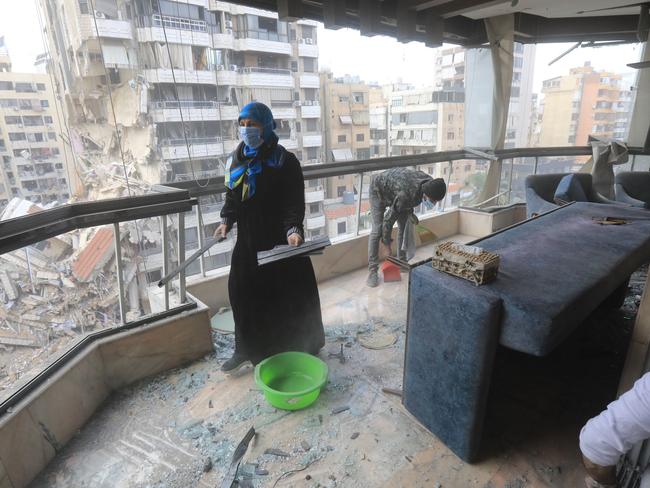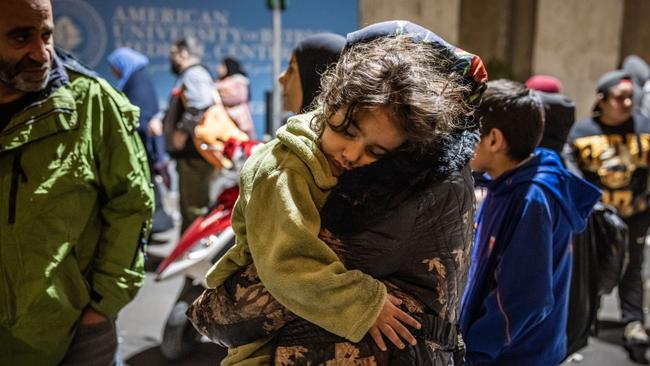Hezbollah and Israel: What new ceasefire means as Lebanese return home
Thousands of displaced civilians returned to Beirut to sift through the remnants of their lives as the Hezbollah and Israel ceasefire was enacted. See what’s at stake with this precarious deal.

World
Don't miss out on the headlines from World. Followed categories will be added to My News.
Lebanon’s leader urged his people to begin their long journey back to normality with hope rather than heartbreak as the ceasefire between Israel and Hezbollah came into effect.
Israeli leaders backed a ceasefire deal that could end over a year of cross-border fighting with Hezbollah, raising hopes and tough questions in the conflict-stricken region which saw 1.3 million people displaced.


The ceasefire was enacted at 4am local time on Wednesday ending over a year of violence that started when Hezbollah began launching strikes against Israel on October 8, 2023, declaring that the attacks would persist as long as Israel continued its war on Gaza.
“Enough wars, tragedies and catastrophes,” Lebanese Prime Minister Najib Mikati said in a televised speech on Wednesday.

“Today begins the thousand-mile road to reconstruct what was destroyed, and to continue to strengthen the role of the legitimate institutions, led by the military, who we place great hopes in to enforce authority on the country.
“Our people have the right to return to their land and towns to live in peace.”
Groups of men waving Hezbollah flags and pictures of assassinated leader Hassan Nasrallah defiantly took to the streets of Beirut in the hours after the ceasefire went into effect.

The Lebanese army issued a statement on Wednesday, confirming they had doubled their presence in southern Lebanon to 10,000 soldiers as per the terms in the ceasefire.
“The army has begun reinforcing its deployment in the South Litani sector and extending the authority of the state in co-ordination with the United Nations Interim Force in Lebanon,” the Army Command statement said.
Lebanese schools, three quarters of which were turned into shelters according to the United Nations, will reopen on Monday.
Hezbollah, along with its Lebanese rivals and allies, have supported an end to the war.
But what are the conditions for a ceasefire, where do things stand at the moment, and is it likely to hold? Here is what you need to know.
WHEN WAS THE CEASEFIRE ANNOUNCED?
Late on Tuesday evening local time Israel’s cabinet agreed to a ceasefire with Hezbollah, hours after Prime Minister Benjamin Netanyahu announced that the security cabinet had approved it and the proposal would move to the full cabinet.
It went into effect on Wednesday at 4am Lebanon time.
“The length of the ceasefire will depend on what happens in Lebanon,” Mr Netanyahu said in an address televised at 5am AEDT.
“With the full understanding of the United States, we are preserving full military freedom of action — if Hezbollah breaks the agreement and seeks to arm itself, we will attack.”

WHAT ARE THE TERMS OF THE CEASEFIRE?
Israeli troops need to pull back from southern Lebanon, while Hezbollah would withdraw north of Lebanon’s Litani River, ending its presence in the region.
This process would take 60 days, with the Lebanese army – largely uninvolved in the current conflict – being deployed to the south to oversee the ceasefire.
If the ceasefire is alleged to have been breached, the international body will convene to discuss the violation.
An international task force headed by the United States, and includes French peacekeepers, would also be deployed to oversee implementation of the truce.
HOW DOES A CEASEFIRE DEAL WORK?
One of the sticking points in the final days leading to the ceasefire’s conclusion was how it would be monitored, Lebanon’s deputy speaker of parliament Elias Bou Saab told Reuters.
A pre-existing tripartite mechanism between the United Nations peacekeeping force in southern Lebanon (UNIFIL), the Lebanese army and the Israeli army would be expanded to include the US and France, with the US chairing the group.
Israel would be expected to flag possible breaches to the monitoring mechanism, and France and the US together would determine whether a violation had taken place, an Israeli official and a Western diplomat told Reuters.
WHY IS THE LITANI RIVER IMPORTANT?
The Litani River is one of the longest rivers in Lebanon, flowing through the southern part of the country and providing a natural boundary.
Its location north of the southernmost regions of Lebanon is a key dividing line between areas controlled by Hezbollah and those under Israeli influence.
The Litani also provides a major source for water supply, irrigation and hydro-electricity both within southern Lebanon, and the country as a whole.
Hezbollah has maintained a presence in southern Lebanon, often using the area for military operations against Israel. The river is seen as a buffer zone between Hezbollah-controlled areas and Israel.
Any withdrawal of forces to the north of the Litani River, as mentioned in ceasefire agreements, symbolises a significant shift in control and military positioning.

WHERE DO DISPLACED PEOPLE GO?
Both Lebanese and Israeli civilians should be allowed to gradually return to their homes.
However, the damage in southern Lebanon is so widespread that it’s unclear how many people will attempt to return.
On the Israeli side, residents from the north may be hesitant to return, as many are expected to be sceptical of the ceasefires durability.
WHAT HAPPENS NOW?
Israel has destroyed around 37 villages and flattened key neighbourhoods in Beirut, Nabatieh, and Tyre.
The majority of those displaced are Shia Muslims, the core demographic that Hezbollah relies on for support. Many of these people will likely be unable to return to their villages for the foreseeable future.
This prolonged and unprecedented displacement could strain relations with host communities from other religious sects.
Lebanon’s sectarian groups experienced intense violence during the Lebanese Civil War (1975-1990), which led to mass displacement and the geographic segregation of the country’s main sectarian communities.
These communities will now be forced to live with each other without much support from the caretaker government, which is reeling from an acute economic crisis.
WHAT’S NEXT FOR HEZBOLLAH?
The presence of the international task force, coupled with domestic opposition to Hezbollah’s militarised role, makes it difficult for the group to restore its previous strength.
WILL THIS AFFECT GAZA AND PALESTINE?
Although the ceasefire will halt the conflict along the Israeli-Lebanese border, there is no indication of any relief in the ongoing war in the Gaza Strip.
Any chance for a ceasefire have dwindled more than a year on, with Qatar withdrawing as a mediator between the two sides earlier this month.

WHAT IS AUSTRALIA’S STANCE ON CEASEFIRE?
Australia welcomed the news of a ceasefire, while also calling on for an end to the conflict in Gaza.
“This is a critical step for alleviating immense human suffering and ensuring displaced communities on both sides of the Israel-Lebanon border can return home.
An end to the violence in Lebanon will also assist in de-escalating heightened tensions in the region,” Foreign Affairs Minister Penny Wong said.
“Australia has been a part of the international coalition pushing for a ceasefire since the escalation of the conflict in Lebanon.
“We commend the tireless efforts of negotiators and call on all parties to adhere to the ceasefire deal.
“An end to the violence in Lebanon must also be a catalyst for an end to the war in Gaza.
“Australia reiterates calls for an immediate ceasefire in Gaza, the unimpeded flow of aid, the protection of civilians, including humanitarian workers, and for the immediate release of all hostages.”




